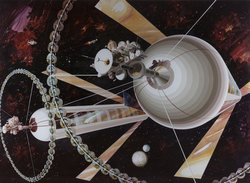Space habitats
 Main Page > Colonising Space > Space habitats
Main Page > Colonising Space > Space habitats
Space is a harsh environment and it may be hard to imagine wanting to live in such a seemingly bleak place, but taming it is only a matter of some (admittedly fairly serious) engineering but is entirely within our current technical capability.
There are many challenges to enable building these towns and cities off-Earth. Two prominent ones are raw materials and gravity. A colony of any size will have to be self-sufficient in materials as it will not be practical to ship them up from the surface of the Earth due to the enormous energy required to climb against its pull. Escaping this pull long-term also causes major problems for the human body. Muscles get very weak, including the heart, and bones de-mineralise. The only real solution is to generate artificial gravity by rotation. (Moon)
There have been many studies over the past thirty years to understand what kind of habitats could be built and what size constraints there are. Surprisingly the answer in the 1970s was that based on bridge and ship-building techniques it is possible to build cylindrical megastructures up to 30 kilometres long and 6 kilometres in diameter with a single one able to comfortably house millions of people.
Being mega-scale engineering projects, it is not hard to see that similar techniques used in the habitat's construction could be used to make the interiors of these habitats be like beautiful places on Earth, like rolling green English countryside for example. Some designs even have enough atmosphere inside them to make the sky appear blue.
Material
It would be far too expensive to built these huge structures from material brought up from the surface of the Earth, so for colonies near Earth it has been proposed to use material mined from the moon or near-Earth objects such as asteroids and comets.

